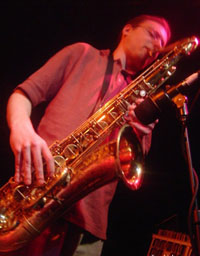
Jeff Sackmann is a composer, saxophonist, and bandleader with an embarrasing affection for bubblegum pop.
In an effort to create serious music for his 15-piece jazz orchestra, Oy Christina!, he has combined baroque fugue with Justin Timberlake, introduced serialism to Eminem, and spiced up dance mixes with Coltrane changes. For his trio Single White Female, among others, he has written several dozen pieces for small jazz ensemble that occasionally bridge the gap between chamber music and traditional combo playing.
As a saxophonist, Jeff spent several months performing with Clyde Stubblefield, the original funky drummer. He plays with a variety of rock bands in New York City and spent three years as the music director for the swing band Little Red and the Howlers.
Hailing originally from Spokane,Washington, he spent his undergraduate years at New York University, did graduate work in English Literature at the University of Wisconsin-Madison,and studied music at Berklee.
|

10.06.2006
Mikel Rouse, The End of Cinematics
I've never really liked going to a performance and not understanding half of what I see right in front of me...but I'm getting used to it. All the better if the music is the focus: that I can usually make some sense out of.
That was what was going through my mind for about the first 20 minutes of Mikel Rouse's new opera, "The End of Cinematics," currently in a week-long run at the Brooklyn Academy of Music's Harvey Theater. It's the third in a trilogy, following "Failing Kansas" and "Dennis Cleveland" (neither of which I've heard or seen). Somehow I had gotten to this point in my life without hearing a note of Rouse's music; luckily, I've read enough of Kyle Gann's stumping for him not to miss this chance.
Initially, "Cinematics" is a visually bewildering experience. The opera opens with movie previews. (Really. Real ones, including a teaser for the Simpsons movie.) Quickly it gives way to three layers of images: a film on a screen the width and breadth of the stage, live performers behind the screen, and six more screens behind them. Sometimes the front screen is empty or see-through; other times it is showing a pre-recorded scene; still others it shows a different angle on one of the performers on stage.
Because of this, there are always multiple things going on onstage; it only becomes less overwhelming due to familiarity. This is by design: more than anything else, the overall effect is like that of a music video. Quick cuts, movements limited by the width of a screen, and incomplete stories. The performers rarely move their feet, dancing and singing as if an imaginary camera has pulled in for a close-up.
Of course, the performance partly invokes music videos because virtually all of the sound for the 75-minute performance is music. Rouse's songs for "Cinematics" defy categorization; I've seen it described by multiple critics as a "pop-opera," which I suppose is as good as you're going to do if you limit yourself to eight letters and a hyphen.
To me, the music sounded like an impossibly good Moby album. Imagine something halfway between a Bang on a Can creation and Moby's "South Side" and you've got a pretty good idea. Rouse is obviously a composer of enormous talent. It's not immediately evident if Cinematics is your first exposure to his music (as it was for me), but the sum total of so many impeccable, interestingly textured pop songs is impressive. One listening certainly doesn't do it justice; if my weekend wasn't packed (including another trip to BAM for Steve Reich tonight) I'd go back and see it again.
posted by Jeffrey Sackmann
|
| |



